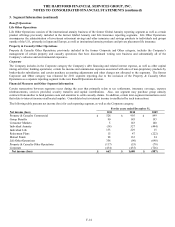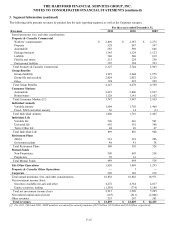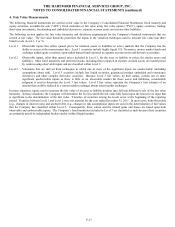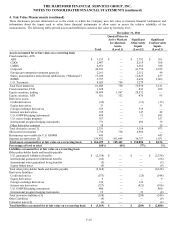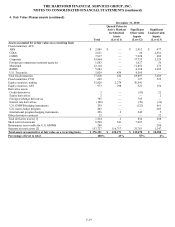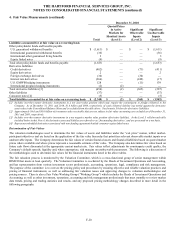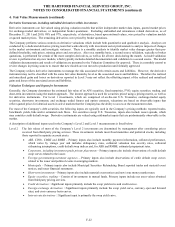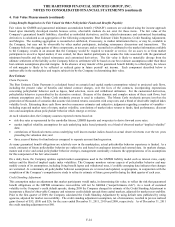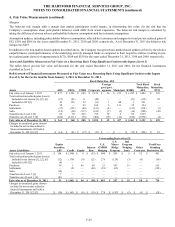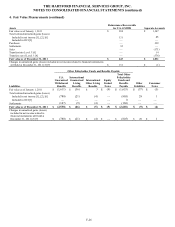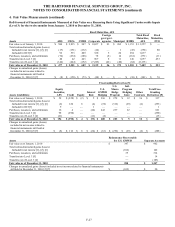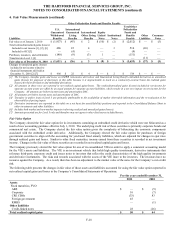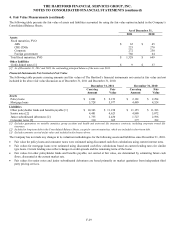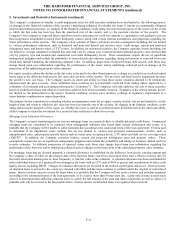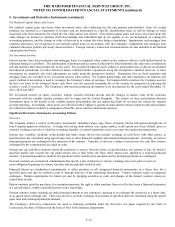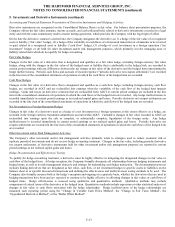The Hartford 2011 Annual Report Download - page 159
Download and view the complete annual report
Please find page 159 of the 2011 The Hartford annual report below. You can navigate through the pages in the report by either clicking on the pages listed below, or by using the keyword search tool below to find specific information within the annual report.THE HARTFORD FINANCIAL SERVICES GROUP, INC.
NOTES TO CONSOLIDATED FINANCIAL STATEMENTS (continued)
F-24
4. Fair Value Measurements (continued)
Living Benefits Required to be Fair Valued (in Other Policyholder Funds and Benefits Payable)
Fair values for GMWB and guaranteed minimum accumulation benefit (“GMAB”) contracts are calculated using the income approach
based upon internally developed models because active, observable markets do not exist for those items. The fair value of the
Company’ s guaranteed benefit liabilities, classified as embedded derivatives, and the related reinsurance and customized freestanding
derivatives is calculated as an aggregation of the following components: Best Estimate Claim Payments; Credit Standing Adjustment;
and Margins. The resulting aggregation is reconciled or calibrated, if necessary, to market information that is, or may be, available to
the Company, but may not be observable by other market participants, including reinsurance discussions and transactions. The
Company believes the aggregation of these components, as necessary and as reconciled or calibrated to the market information available
to the Company, results in an amount that the Company would be required to transfer or receive, for an asset, to or from market
participants in an active liquid market, if one existed, for those market participants to assume the risks associated with the guaranteed
minimum benefits and the related reinsurance and customized derivatives. The fair value is likely to materially diverge from the
ultimate settlement of the liability as the Company believes settlement will be based on our best estimate assumptions rather than those
best estimate assumptions plus risk margins. In the absence of any transfer of the guaranteed benefit liability to a third party, the release
of risk margins is likely to be reflected as realized gains in future periods’ net income. Each component described below is
unobservable in the marketplace and require subjectivity by the Company in determining their value.
Best Estimate
Claim Payments
The Best Estimate Claim Payments is calculated based on actuarial and capital market assumptions related to projected cash flows,
including the present value of benefits and related contract charges, over the lives of the contracts, incorporating expectations
concerning policyholder behavior such as lapses, fund selection, resets and withdrawal utilization. For the customized derivatives,
policyholder behavior is prescribed in the derivative contract. Because of the dynamic and complex nature of these cash flows, best
estimate assumptions and a Monte Carlo stochastic process is used in valuation. The Monte Carlo stochastic process involves the
generation of thousands of scenarios that assume risk neutral returns consistent with swap rates and a blend of observable implied index
volatility levels. Estimating these cash flows involves numerous estimates and subjective judgments regarding a number of variables –
including expected market rates of return, market volatility, correlations of market index returns to funds, fund performance, discount
rates and assumptions about policyholder behavior which emerge over time.
At each valuation date, the Company assumes expected returns based on:
• risk-free rates as represented by the eurodollar futures, LIBOR deposits and swap rates to derive forward curve rates;
• market implied volatility assumptions for each underlying index based primarily on a blend of observed market “implied volatility”
data;
• correlations of historical returns across underlying well known market indices based on actual observed returns over the ten years
preceding the valuation date; and
• three years of history for fund indexes compared to separate account fund regression.
As many guaranteed benefit obligations are relatively new in the marketplace, actual policyholder behavior experience is limited. As a
result, estimates of future policyholder behavior are subjective and based on analogous internal and external data. As markets change,
mature and evolve and actual policyholder behavior emerges, management continually evaluates the appropriateness of its assumptions
for this component of the fair value model.
On a daily basis, the Company updates capital market assumptions used in the GMWB liability model such as interest rates, equity
indices and the blend of implied equity index volatilities. The Company monitors various aspects of policyholder behavior and may
modify certain of its assumptions, including living benefit lapses and withdrawal rates, if credible emerging data indicates that changes
are warranted. At a minimum, all policyholder behavior assumptions are reviewed and updated, as appropriate, in conjunction with the
completion of the Company’ s comprehensive study to refine its estimate of future gross profits during the third quarter of each year.
Credit Standing Adjustment
This assumption makes an adjustment that market participants would make, in determining fair value, to reflect the risk that guaranteed
benefit obligations or the GMWB reinsurance recoverables will not be fulfilled (“nonperformance risk”). As a result of sustained
volatility in the Company’ s credit default spreads, during 2009 the Company changed its estimate of the Credit Standing Adjustment to
incorporate a blend of observable Company and reinsurer credit default spreads from capital markets, adjusted for market recoverability.
Prior to the first quarter of 2009, the Company calculated the Credit Standing Adjustment by using default rates published by rating
agencies, adjusted for market recoverability. The credit standing adjustment assumption, net of reinsurance, resulted in pre-tax realized
gains (losses) of $55, ($10) and $26, for the years ended December 31, 2011, 2010 and 2009, respectively. As of December 31, 2011
the credit standing adjustment was $80.


